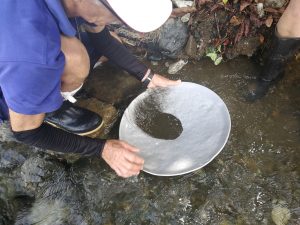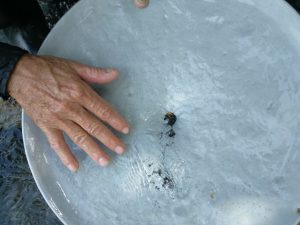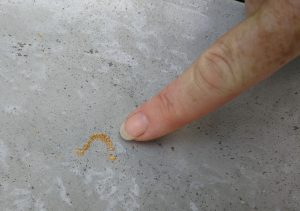Do you feel lucky? Most people come to Costa Rica to spend a fortune, so why not buck the trend and find a fortune instead? All you’ve got to do is go panning for gold … and get lucky.
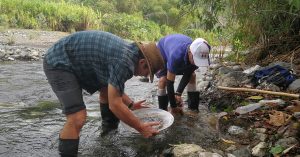 We came across the Canoas border from Panama and turned left into the Osa Peninsula. Here, all we had planned was a bit of critter-spotting and some lounging around on the beautiful, remote, unpopulated beaches. But whilst I was doing some of said lounging around by the sparkling turquoise ocean with macaws screeching overhead, I read about a local gold-rush. I’d never heard of Costa Rican gold but as recently as the 1970s, prospectors flocked to the nearby hills in search of life-changing golden nuggets. The rush tapered off in the ’80s, but locals are now cleverly turning this relatively recent heritage into a small-scale tourist attraction and offering low-key, panning for gold experiences. It’d be rude then, not to give it a go.
We came across the Canoas border from Panama and turned left into the Osa Peninsula. Here, all we had planned was a bit of critter-spotting and some lounging around on the beautiful, remote, unpopulated beaches. But whilst I was doing some of said lounging around by the sparkling turquoise ocean with macaws screeching overhead, I read about a local gold-rush. I’d never heard of Costa Rican gold but as recently as the 1970s, prospectors flocked to the nearby hills in search of life-changing golden nuggets. The rush tapered off in the ’80s, but locals are now cleverly turning this relatively recent heritage into a small-scale tourist attraction and offering low-key, panning for gold experiences. It’d be rude then, not to give it a go.
Panning for Gold in Costa Rica
We’ve always found the whole gold-panning thing rather fascinating. Just how did those gold-rush guys find the life-changing nuggets amongst acres of grit? We’d thought we might get to check this out when we reached the Yukon… one day. But as we’re here, surely it’s got to be better to do it in the sunshine and warm waters of Costa Rica? I’ve never been one for getting both cold and wet at the same time. Also, an important reason more worthy than to merely satisfy our idle curiosity, is to support these small-scale, local tourism initiatives, helping rural communities. Reporting to the office in the tiny hamlet of Dos Brazos, we found Alvaro who took us down to the river, explaining a bit about the history on the way.
In our wellies in the shallow river, we followed Alvaro’s guidance and started hacking away at the mud and large stones which form the low riverbank. It’s not tightly packed and the rubble broke fairly easily into the river. Alvaro then started panning for gold… scooping-up some of the mud, grit and stones out of the river and into the pan. He showed us how to swirl the matter around the pan, just slightly under the water, allowing the heavier flecks of gold to separate from the lighter grit in the pan.
Back-breaking stuff
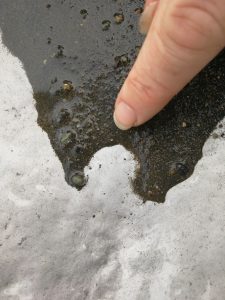
How did he spot that???
As he swirled, it took him only a few minutes to point out the first tiny flecks of gold amongst the grit. Blimey… how the devil did he spot these tiny flecks, weenier than a gnat’s whatsit? We couldn’t spot them at first, but as he angled the pan towards the sun it was easier to see that these dots did indeed sparkle in the sunlight much more brightly than the other pale-coloured particles in the grit.
So, on we went with the panning for gold, crouching in the shallow river-flow, scouring for that elusive golden-nugget. After a while, Alvaro confessed that this is actually a rather inefficient system. “It’s back-breaking work…” he said “… and there’s such a tiny amount of gold in each pan-full of grit”. Really Alvaro? Can’t say we’d noticed 😉.
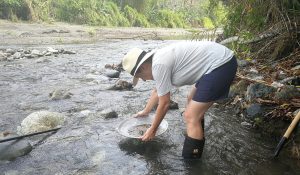 A more efficient method is to place a long oblong, metal tray in the water-flow, lodging it between some rocks. In the tray is a piece of carpet, held in place by an iron mesh. Alvaro showed us how to shovel spade-fulls of stones, grit and mud into the metal tray so that it flowed over the carpet and out the other side of the tray. He explained how gold is heavy and dense; how the small pieces of gold sink and stick in the carpet fibres; how most of the lighter, less-dense mud, rocks and debris will flow-on with the river water.
A more efficient method is to place a long oblong, metal tray in the water-flow, lodging it between some rocks. In the tray is a piece of carpet, held in place by an iron mesh. Alvaro showed us how to shovel spade-fulls of stones, grit and mud into the metal tray so that it flowed over the carpet and out the other side of the tray. He explained how gold is heavy and dense; how the small pieces of gold sink and stick in the carpet fibres; how most of the lighter, less-dense mud, rocks and debris will flow-on with the river water.
It all seemed rather unlikely, but we nevertheless humoured the chap and shovelled-on and on. This too was back-breaking work, although it has to be said, not as back-breaking as the panning. Eventually it was time to check-out our new-found wealth! Alvaro took the carpet out of the tray and rinsed it with river water; the carpet fibres deposited large amounts of mud and grit into the pan. Here started the magic!!
A Phial of Magic
Alvaro took the pan full of grit and began swilling it around with the same skilful circular motion that he had demonstrated earlier. He kept adding splashes of water to the pan, which swirled around depositing the lighter grit to the edges of the pan. He expertly flicked this lighter grit into the river, whilst the heavier matter sank to the lower, central point of the pan.
- From this…
- … to this…
- … and finally this!
He did this over, and over again, for around 4 or 5 minutes: adding water, swirling it around, flicking out the lighter grit, bit by bit. Eventually, and without the aid of a magic wand, many golden flecks started to appear in the ever-decreasing amounts of grit in the pan. There were far more, and they were far easier to see, than the one or two specks that he had found in the earlier pan-fulls of grit.
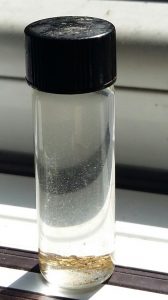
Gold!!!
Alvaro continued painstakingly, reducing and reducing the grit in the pan until only the densest but tiniest pieces were left – just the flecks of gold – nothing else at all!! It was mind-blowing to watch this reduction process, how from a river-bank of stones, grit and mud Alvaro could produce a small pile of admittedly teeny-weeny, but very clear, pieces of gold.
For the final pièce de résistance, Alvaro produced from his bag, a small screw-topped phial. He filled it with river water, before sliding the tiny pile of gold flecks out of the pan and into the phial for us to take away.
Getting rich quick?
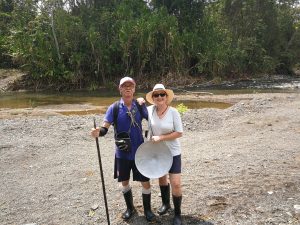
The Panning for Gold Meister
So what about the getting rich quick? Well, Alvaro told of how this low-land part of the river had been cleared out by US and Canadian contractors using huge machinery in the early ‘80s – a kind of industrial panning for gold. There is very little gold left down here and there’s certainly none of any real commercial value. Hmmm… so that’s why they bring the tourists here. So much for the get-rich-quick idea 😊.
However, there is apparently still plenty of gold in the surrounding jungle. Around 2,000 families in them-there hills make a living solely from gold prospecting. There was an attempt by the government to either plunder the gold for the national coffers, or to tax anyone who benefited from finding a decent chunk. But it proved harder than they thought. The mountain folk closed ranks and kept the best golden nugget spots to themselves. When Government agents went up there to try to find the spots, the locals sat back and watched in amusement. Ha! Unlucky suckers!
When the villagers find larger nuggets, they break them up and sell them off in smaller chunks so as not to attract government attention or to flood the local market. It’s all very clandestine, but it works for them.
Okay… so clearly panning for gold in Costa Rica is not likely to get you rich quick. But we did come away with our very own bit of gold. Our new-found wealth now sits in its own little jar, with not a single grain of grit in there with it. Seriously impressive skills Alvaro. And a fascinating morning.

